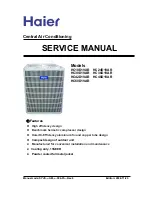
8
AHU Kit – Installation Instructions –
11/2021
General information and safety notes
1
1.2 Safety notes
To avoid possible harm to persons or damage to products, read and follow these safety notes.
WARNING
The following precautions need to be followed strictly, in order to avoid hazardous situations, which
could result in death or serious injury.
Electric shock or fire may result from inadequate or incorrect installation or wiring
procedures.
► System installation must only be performed by an experienced electrician.
►
Arrange installation at the dealer where the system was purchased or use a professional
installer.
► System installation must be performed in strict accordance to the installation procedures
described in this document.
Damage to the circuit breakers may result from incorrect electrical wiring, insufficient
electrical circuit capacity or use with other electrical devices.
►
Always use a dedicated circuit for electrical wiring.
► Strictly avoid using other electrical devices within the same electrical circuit.
► Make sure the electrical circuit used has sufficient capacity.
Overheating or fire may result if connections or attachments are not secure.
► Use the specified cables (type and wiring diameter) for the electrical connections, and
securely connect the cables.
► Run and fasten the cables securely so that external forces or pressure placed on the
cables will not be transmitted to the connection terminals.
Suffocation can result if refrigerant gas leaks and exceeds the limit density in a small room.
► Installation of the refrigerant piping must only be performed by an experienced, qualified
installer to minimize the risk of leaks.
► Install so that even if refrigerant gas leaks into the installation space, it will not exceed the
practical limit density of 0.44 kg/m
3
for
R410A
and 0.061 kg/m
3
for
R32
, in accordance
with the local regulations for facility air conditioning equipment. However, for further limits
and calculations to be done, see
→
1.3 Instructions for the safe handling of R32, p. 9
► If the refrigerant gas concentration does exceed the density limit, do one of the following:
● install an opening in a neighbouring room
● or install ventilation equipment triggered by gas leak detection sensors
● or install an automatic shut off and/or pump-down system provided by the man
-
ufacturer of the equipment
Poisonous gas can result if refrigerant gas comes into contact with fire.
► After installation of refrigerant pipes, perform a dry nitrogen gas sealing test to check that
there are no leaks.
► Ventilate the work area if refrigerant gas leaks during installation.
► Prevent the refrigerant gas from coming into contact with a fan heater, stove, range, or
other source of ignition.
Содержание PAW-280PAH3M-1
Страница 2: ...Notes ...
Страница 113: ...Notes ...





































